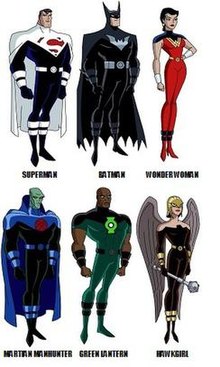
Alexander Joseph "Lex" Luthor is a supervillain appearing in American comic books published by DC Comics. The character was created by Jerry Siegel and Joe Shuster. Lex Luthor originally appeared in Action Comics #23. He has since endured as the archnemesis of the superhero Superman.

Brainiac is a supervillain appearing in American comic books published by DC Comics. The character was created by writer Otto Binder and artist Al Plastino, and debuted in Action Comics #242. He has since endured as one of Superman and the Justice League's greatest enemies. The character's name is a portmanteau of the words brain and maniac.

Doomsday is a supervillain appearing in American comic books published by DC Comics, commonly as one of Superman's deadliest foes. Created by writer-artist Dan Jurgens, the character had a cameo appearance in Superman: The Man of Steel #17 and made his first full appearance in Superman: The Man of Steel #18.

Superman: Red Son is a three-issue prestige format comic book mini-series published by DC Comics that was released under their Elseworlds imprint in 2003. Author Mark Millar created the comic with the premise "What if Superman had been raised in the Soviet Union?" It received critical acclaim and was nominated for the 2004 Eisner Award for best limited series.
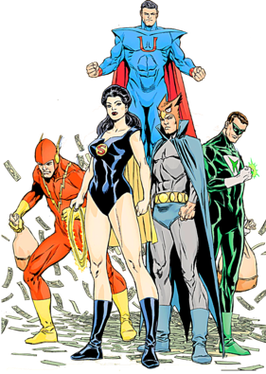
The Crime Syndicate are teams of supervillains from one of DC Comics' parallel universes where they are the evil counterparts of the Justice League. The original team was specifically known as the Crime Syndicate of America and is sometimes abbreviated as CSA. This first superpowered Crime Syndicate team appeared in Justice League of America #29 in August 1964. The primary successive incarnation, known as the Crime Syndicate of Amerika, first appeared in the 2000 JLA: Earth 2 graphic novel.

The Fortress of Solitude is a fictional fortress appearing in American comic books published by DC Comics, commonly in association with Superman. It is the place where Superman first learned about his true identity, heritage, and purpose on Earth. The fortress functions as a place of solace/occasional headquarters for Superman and is typically depicted as being in frozen tundra, away from civilization. Its predecessor, Superman's "Secret Citadel", first appeared in Superman #17, where it was said to be built into a mountain on the outskirts of Metropolis. By issue #58 it is referred to as the Fortress of Solitude, seems at a glance to be a freestanding castle, and is said to be located in a "polar waste". When the Fortress reappears in 1958 and for the first time takes center stage in a story, it is again an underground complex in a mountainous cliffside.

Batman: The Dark Knight Strikes Again, also known as DK2, is a 2001–2002 DC Comics three-issue limited series comic book written and illustrated by Frank Miller and colored by Lynn Varley, featuring the fictional superhero Batman. The series is a sequel to Miller's 1986 miniseries The Dark Knight Returns. It tells the story of an aged Bruce Wayne who returns from three years in hiding, training his followers and instigating a rebellion against Lex Luthor's dictatorial rule over the United States. The series features an ensemble cast of superheroes including Catgirl, Superman, Wonder Woman, Plastic Man, Green Arrow, The Flash, and the Atom.

Metallo is a supervillain appearing in American comic books published by DC Comics, commonly as an adversary of Superman. He is usually depicted as a cyborg with a kryptonite power source in his heart, which he uses as a weapon against Superman. In 2009, Metallo was ranked as IGN's 52nd-greatest comic book villain of all time.

JLA: Earth 2 is a graphic novel written by Grant Morrison with art by Frank Quitely, published in 2000 by American company DC Comics.

Mercy Graves is a supervillain appearing in multimedia and American comic books published by DC Entertainment and DC Comics. Created for the DC Animated Universe (DCAU), she first appeared in 1996 on Superman: The Animated Series as the personal assistant and bodyguard of Superman's archenemy Lex Luthor, returning in Justice League and Justice League Unlimited, voiced by Lisa Edelstein. She has since been introduced into comic books published by DC Comics.
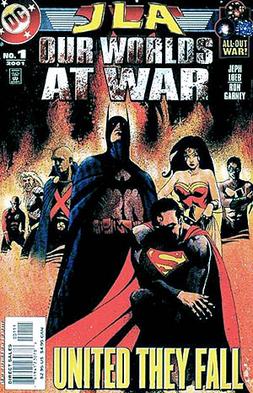
"Our Worlds at War" was a comic book storyline, published by DC Comics in mid-2001. OWAW was a crossover storyline that spanned several different books, including several books starring Batman, Superman and Wonder Woman, The Flash, Green Lantern, and a number of supporting characters and books. Creators involved in the crossover included writers Jeph Loeb, Joe Casey, Mark Schultz, Joe Kelly, Phil Jimenez, and Peter David, and artists that included Mike Wieringo, Ed McGuinness, Doug Mahnke, Ron Garney, and Leonard Kirk.

Justice is a twelve-issue American comic book limited series published bimonthly by DC Comics from August 2005 through June 2007, written by Alex Ross and Jim Krueger, with art also by Ross and Doug Braithwaite. Its story involves the superhero team known as the Justice League of America confronting the supervillain team the Legion of Doom after every supervillain is motivated by a shared dream that seems to be a vision of the planet's destruction, which they intend to avoid.
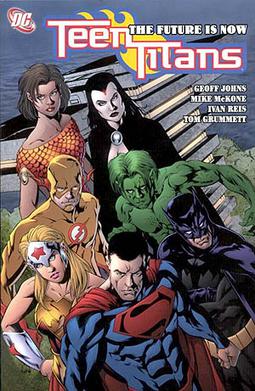
"Titans Tomorrow" is a storyline of a possible alternate future in the DC Comics Universe, from Teen Titans vol. 3 #17–19 (2005), by Geoff Johns and Mike McKone. The story arc has been collected as part of the Teen Titans: The Future is Now trade paperback.
DC Universe: Justice League Unlimited Fan Collection is an action figure line based on the highly popular Justice League and Justice League Unlimited animated series. Though it was based on the show(s), the line has continued well beyond it, and has been re-branded in 2008, as a Target exclusive. Mattel announced in February 2011 that the line would come to an end later in the year with the final figures being released on the Mattel website including the final two three-packs, a seven-pack as well as the three exclusive Con three-packs being made available to the public.
Lex Luthor is a fictional supervillain appearing in American comic books published by DC Comics. As Superman's archenemy, he has been portrayed in almost every Superman media franchise and adaptation.
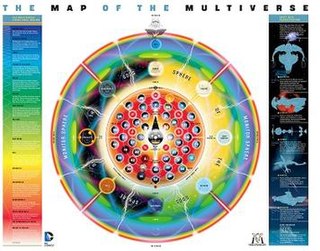
In most of the DC Comics media, the Multiverse is a "cosmic construct" composed of the many fictional universes the stories of DC media take place in. The worlds in the multiverse share a space and fate in common, and its structure has changed several times in the history of DC Comics.
The Bizarro League, also known as the Bizarro Justice League, are the Bizarro version of the Justice League.

Robot Chicken DC Comics Special is an episode of the television comedy series Robot Chicken and it was aired as a one-off special during Cartoon Network's Adult Swim on September 10, 2012.
Robot Chicken DC Comics Special III: Magical Friendship is an episode of the hit TV show, Robot Chicken and aired as a half-hour special during Cartoon Network's Adult Swim on October 19, 2015. It is the third and final special in the Robot Chicken DC Comics Specials series, following Robot Chicken DC Comics Special and Robot Chicken DC Comics Special 2: Villains in Paradise.
